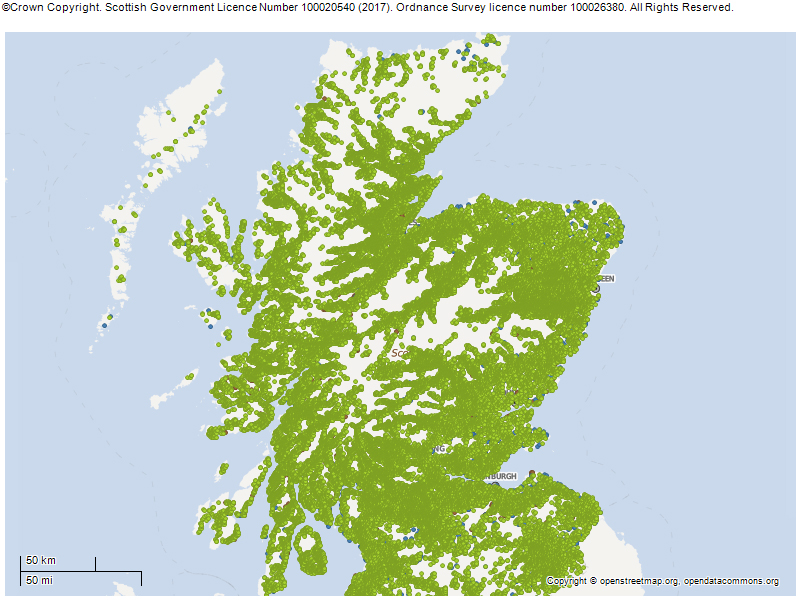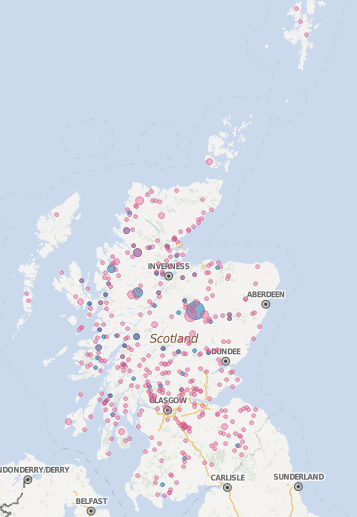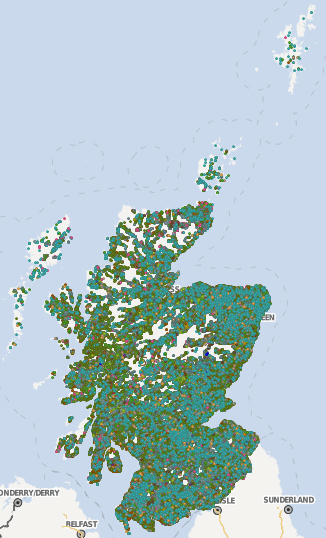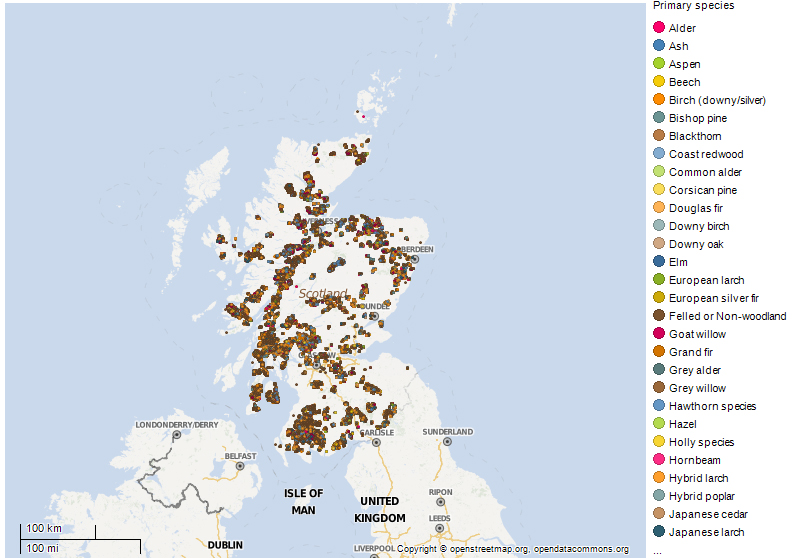Scotland’s woodlands and forests support a wide range of important plants and animals. While rare and threatened species are often found in higher densities in and around semi-natural woodlands, plantation woodland (both broadleaved and conifer) also has a role to play in supporting Scotland’s wildlife.
Key messages
- Woodlands and forests support a large part of Scotland’s terrestrial wildlife. Forests (or woodlands) comprise the land, of at least 0.1 ha, under stands of trees with a canopy cover of at least 20%, or having the potential to achieve this, including the integral open space, as well as any felled areas awaiting replanting.
YouTube: Wildlife in Central Scotland’s woods and forests
- Greater biodiversity (the variety of life – different species, genetic variation, all habitats and ecosystems, and the way they interact with each other) tends to be associated with woodlands that are diverse and complex with a mosaic of areas with different plant types, age, structure, and varying openness. Woods that have more tree species or a larger proportion of native species tend to be more diverse but mixed and plantation woodlands can also offer biodiversity value if well managed.
- Native woods can be semi-natural (self-sown) or planted. They are defined as woods in which over 50% of the canopy is made up of species native to the region. Unfortunately, most of our native woodlands are not specifically protected (e.g. SSSI) for their biodiversity value, despite being home to important wildlife. However, there are policies to prevent their unnecessary loss through mechanisms such as the planning system (all local authorities are required to have a woodland and forestry strategy) and the Control of Woodland Removal policy, see below.
- Human influence and climate change had reduced forests to only 4.5% of Scotland’s land area by the start of the 20th century. No woodlands in Scotland can now be considered truly natural. Since then, a huge woodland creation effort has significantly increased Scotland’s forest area. In recent years, up to 40% of new woodland creation has been for native woodland.
- Woodlands that have been continuously present in some form for at least 270 years are known as ancient woodlands. Native and ancient woods generally have a high value for biodiversity.
- A plantation is woodland where the trees are directly planted, as opposed to naturally spreading (or regenerating) through seed dispersal. Plantations can be made of native, non-native, or mixed species. Some plantation woodlands can be created to supply a particular product, such as boards for construction or pallets and fibre for paper or biomass. However modern plantations increasingly have wider or multiple objectives, such as sequestering carbon, for habitat connectivity and resilience, and for landscape reasons.
YouTube: There’s more to Scotland’s forests than meets the eye
- Climate change is expected to make Scotland a warmer, wetter and windier place, with more extreme weather. The factors determining our climate 50 years from now are not fully understood, but there will be positive and negative effects on trees and woodland wildlife.
- Salmon require access to cool, clean water to thrive. At water temperatures above 23⁰C salmon experience thermal stress. With climate change, these temperatures are expected to occur every other year by 2050 in Scotland. Targeted planting of riparian trees along rivers provides shading to reduce water temperatures while providing other benefits for water quality and flood management. Find out more about Scotland’s River Temperature Monitoring Network; and the objectives set out to restore wild salmon populations in the Scottish Wild Salmon Strategy.
Data
View forest and woodland data on Scotland’s environment web:
The Native Woodland Survey of Scotland (NWSS) was carried out from 2006-2013 to establish the first authoritative picture of Scotland’s native woodlands.
Search the broad range of Scotland’s protected nature sites that includes woodland features of interest, to examine their location, condition and any pressures on the condition. NatureScot also has information specially developed to provide access to information on Protected Areas across Scotland.
National Forest Inventory – This application provides information about the size, distribution and composition of all forests and woodlands in Scotland and is essential for developing and monitoring policies and guidance to support their sustainable management. This application provides a visual analysis for Scotland and it forms part of the wider surveys carried out on forests and woodlands across Great Britain.
Scotland's National Forests and Land - This application gives a visual analysis of the National Forests and Land managed by Forestry and Land Scotland – providing information on the trees and forests it manages. The information has a range of valuable uses, for example:
- Enables economic, environmental and social forest-related decision-making by Forestry and Land Scotland, government, industry and public
- helps us meet our national and international forest-related reporting responsibilities
- informs planning assessments and decisions when looking at the development of processing industries, regional infrastructure and the effect of forestry related actions on communities.
A wide range wide range of forestry datasets are available - including statistics and economic research, National Forest Inventory, GIS data download, register of approved basic material.
What are we doing?
Good-practice standards for managing woodlands and guidance for biodiversity are available in the UK Forestry Standard (UKFS) and associated guidelines.
The Scottish Forestry Strategy 2019 - 2029 outlines the Scottish Government’s ambition for forestry in Scotland. Underpinned by sustainable forest management principles, the Forestry Strategy aims to expand Scotland’s forests and woodlands and to deliver multiple benefits. The Forestry Strategy Implementation Plan 2022 - 2025 sets out emerging priorities and actions to be delivered which will progress the long-term objectives of the Forestry Strategy.
The 2020 Challenge for Scotland’s Biodiversity, sets out ambitious policy proposals for restoring nature and getting more benefits from it, including improving the condition of native woodlands identified in the Native Woodland Survey of Scotland. Forest Research has created a new analysis method to determine the ecological condition of Scotland’s woodlands (both plantation and semi-natural) to help inform policy and land management decisions. The Woodland Ecological Condition assessment is based on NFI data and uses 15 indicators of woodland ecological condition and a further classification of woodland habitat into its condition status of favourable, intermediate and unfavourable.
Under the Scottish Government's Control of Woodland Removal Policy, loss of woodland should only be permitted if it results in significant public benefits. Planting in other areas to make up for any loss of woodland is often expected.
Development-planning policies also influence the location and character of woodland expansion through Forest and Woodland Strategies and encourage the development of green networks, notably the Central Scotland Green Network and soon Nature Networks.
Guidance is available to help:
The Forestry Grant Scheme supports new woodland creation and sustainable management of existing woodlands. Enhanced grant rates will soon be available for planting within riparian woodland opportunity target areas, which provide multiple benefits.
The Land Information Search (LIS) for Agri-Environment and Forestry should be used by applicants for Scotland Rural Development Programme (SRDP) Forestry Grant Scheme contracts or forest felling permissions. The tool allows you to run a map-based search to highlight the presence of a range of environmental features and designations such as Scheduled Monuments, Sites of Special Scientific Interest and Native Woodlands that may fall within an area of interest and within a 500 m buffer.
Planning and managing woodlands is generally best considered over the long term and on a landscape or whole forest scale, within a regional context. Long-term forest plans are in place for all the national forests and land, and are a condition of grant aid for management in private woodlands. These plans set out, for a period of at least 20 years, how the forests will be managed and what changes will be made to meet the objectives of the plan and to comply with the UK Forestry Standard.
Land Management Plans are in place for all the national forests and land, which detail how FLS will manage a specific area of land over a period of 10 years.
Increasing demand for public use of woodlands is being met by encouraging more planting and management of woods in and around towns.
As well as removing emissions at source, good river-basin planning and site management can reduce the effects of nitrogen enrichment on woodland biodiversity. Careful management of livestock grazing may also help. The UKFS guidelines on forests and water include measures to minimise the effects of acid rain.
Scotland’s forests are at risk from tree pests and diseases. Climate change, global travel and imported plants and wood can increase pests and diseases and their impacts. These can dramatically affect the health of our trees and timber quality, upsetting the delicate ecosystem balance and devastating large areas of woodland.
Information on tree health in Scotland, including Action Plans and outbreak update maps for specific tree pests and diseases can be found on the Scottish Forestry website. Scotland's Plant Health Centre is also a useful source of information on tree health research in Scotland. Suspected findings of tree pests and diseases can be reported via the Tree Alert portal.
‘Keep it Clean’ is a public information campaign to encourage behaviours that reduce the risk of spreading tree pests and diseases in Scotland’s forests and woodlands.
YouTube: Keep it clean
Scotland has one of the greatest health challenges of Europe's developed nations. Scottish Forestry and the whole forest sector can contribute positively to the health agenda. A key objective of Scotland’s Forestry Strategy is to increase the use of Scotland’s forests to enable more people to improve their health, wellbeing and life chances. Scottish Forestry is involved in a number of programmes and partnerships that demonstrate the role Scotland’s forests can play in improving health and wellbeing.
Policy and legislation
Woodland creation and forest management is regulated by Scottish Forestry, mainly under the Forestry and Land Management (Scotland) Act 2018 and The Forestry (Environmental Impact Assessment) (Scotland) Regulations (2017).
Other environmental protection legislation that applies to woodlands includes:
Under the Wildlife and Natural Environment (Scotland) Act 2011, Scottish Forestry, Marine Scotland and SEPA have powers and responsibilities to tackle problems caused by Invasive Non-Native Species (INNS).
This page was updated on 02 Mar 2023
Adobe Acrobat Reader is the free, trusted leader for reliably viewing, annotating and signing PDFs.
Download Adobe Acrobat Reader




